Tatton Flower Show 2008
It really doesn't seem 10 years since the RHS decided to acknowledge the north of England as the true cultural hub of the country and belatedly establish a flower show in the grounds of Tatton Hall, one of the many dilapidated mill-workers' cottages that are dotted about the region. What's really worrying is that I attended the first show along with three of the Reichskinder hell-bent on ruining the day for me, and now, a decade on and the kids are gone, busy messing up their own lives with an assortment of ne'er-do-well boyfriends and occasional careers.
Despite all these changes, the RHS Tatton Flower Show has remained fairly constant. The weather is always a bit of a gamble, normally settling somewhere between overcast and chucking-it-down, the attendance is always high, and both the number and quality of gardens on show is pleasantly suprising. Tatton doesn't suffer from the intense media spotlight of those lesser, southern-based shows, so there are fewer bewildered zelebrities cluttering the place, fewer no-connection-to-gardening-whatsoever corporate sponsors and far fewer society butterflies with trophy partners. Instead, there are genuinely enthusiastic designers, contractors and gardeners all desperate to show what they can achieve.
And while Chesley may be the show that establishes trends and fashions, Tatton has always revelled in less flighty northern tastes and sensibilities. A significantly higher proportion of the gardens at Tatton are what might be termed "realistic" rather than fanciful; they would be achievable by 90% of the public rather than the 0.1% of population high-net-worth-individuals that often seems to be the target audience of the London-based events. That's not to say there is no adventure or experimentation with some of the gardens; there is, but it is considered and cautious rather than outlandish or outrageous.
Contrasts with Chesley are inevitable, but I'm not sure such comparisons are always warranted as each plays to a different audience with different values. However, the one abiding trend noted at the Royal Hospital back in May was the use of native natural stone on most of the show gardens. Tatton has always featured gardens making good and varied use of native natural stone, notably the Pennine gritstones and yorkstones that dominate much of the older civic architecture in northern towns and cities. This year was no different, although a good number of gardens featured crazy paving rather than rectangular slabs or flagstones. And to think it is only 5 weeks since I was discussing the demise of crazy paving as a surfacing with one of Ireland's largest stone paving producers!
Best in Show Gardens
Judging was still taking place while I was wandering around on Tuesday morning, but the results were posted later that afternoon and it really comes as no surprise to learn that the Chris Beardshaw designed Celebrating Cheshire's Year of Gardens won best in show as it was a true representation of what many real gardener's love to see: deliciously packed borders with a nice stripey lawn.
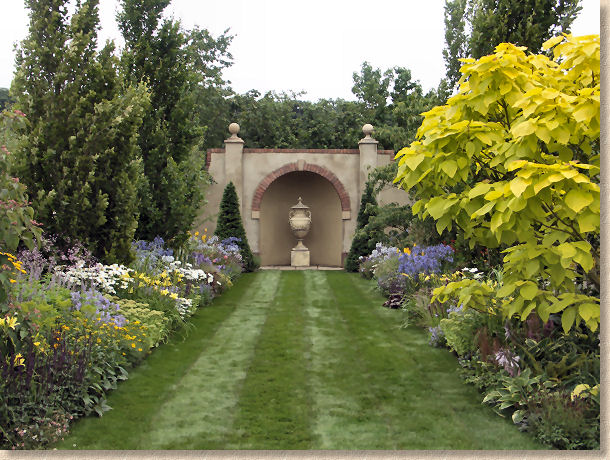
Personally, I was disappointed that what little paving was present was a totally characterless Indian sandstone laid as a straight path. Doesn't such a luscious garden deserve genuine northern stone?
Believe it or not, good Pennine gritstone flags can be found in Cheshire, from the Kerridge quarries on the outskirts of Macclesfield. If we're going to celebrate Cheshire's gardens, why not use Cheshire stone?
Maybe as this was Mr Beardshaw's first venture north, he was unaware of our rich paving heritage, but somebody from Cheshire Council, who paid for the garden, ought to have had a word, surely!
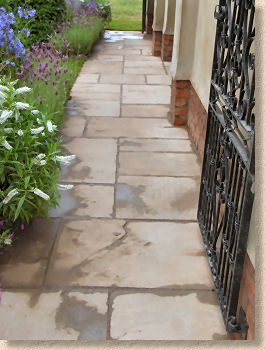
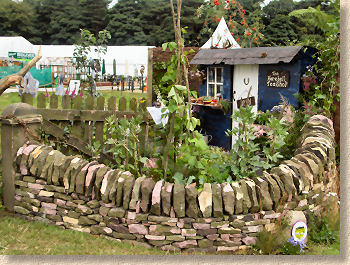
In fact, one of the neighbouring Back-to-Back gardens, the silver-medal winning Harebell Teashop by Cheshire Countryside along with Rights of Way had been built specifically to promote The Gritstone Trail , a spectacular pathway through much of Cheshire's gritstone highlands, and passing right through Kerridge. This is one of those 'lost-in-time' gardens tinged with whimsy and nostalgia, but ignoring that, you have to admire the fantastic dry stone walling that surrounds the garden. Built by John Robertson (T: 01625 576755 - true craftsmanship deserves recognition!) it's a thing of beauty in its own right.
On the subject of awards, the best Back-to-Back effort was deemed to be the 5 a Day Play Garden from the Reaseheath Alumni, and it's hard to argue with that decision. It's a modern garden aimed at families with young kids and perfectly hits the centre of the venn diagram depicting the needs of adults, children, veg/fruit-growing and aesthetics.
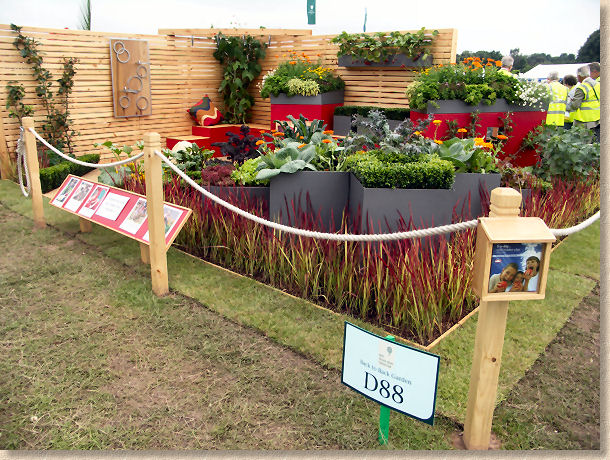
The surfacing is a three-colour bound crumb rubber that protects young children's knees from the inevitabilities of gravity and friction, while being supremely easy to hose down once the little darling's have redistributed their stomach content's following a sugar-induced manic session of running around in circles and jumping off furnishings. An exceptionally well thought out garden, with superb attention to detail and impeccable presentation.
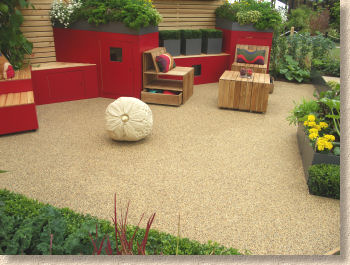
Best Laid Paving
However, if I had to pick out the best paving in a small back-to-back garden, that award would have to go to Chester Zoo's delicious cobble-pebble path on their Butterfly Journey Garden , built to celebrate the new Butterfly House at the zoo, due to open later this year.
This type of paving is not easy to do well, and the in-house team from Chester Zoo deserve enormous credit for doing such a wonderful job worthy of any professional contractor. I've seen a number of similar paths this summer: there's some owld guff going around that they are "Reiki Paths" and that they provide a massage when walked over in barefeet. I don't know enough about Reiki to say whether that's true or not; I do know my dad was laying paths like this in the 1950s and I'm damned certain they didn't have Reiki in that part of Ireland back then!
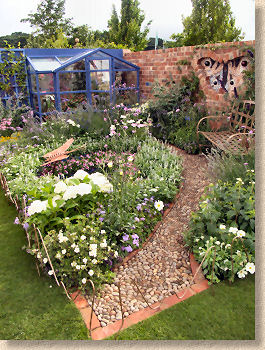
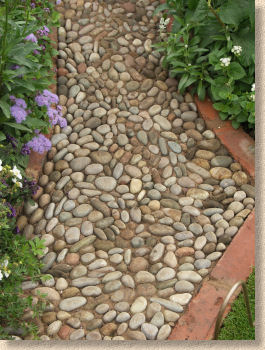
Whatever, this cobble-pebble (the hyphen is there because the official definition is that cobbles are 64-256mm in size, whereas pebbles are 4-64mm) is exceptionally well laid, with barely a hint of the bed matrix (a simple sand-cement mortar) showing. That's the key to success with this type of paving: selecting the best size and shape of stone to lay next in order to minimise the amount of matrix that is visible, and all without staining the surface.
Crazy for Crazy Paving
So, where's all that crazy paving I mentioned? Well, it's dotted around various gardens, and while much is yorkstone/gritstone, there are some intriguing variations including quartz and pre-cast.
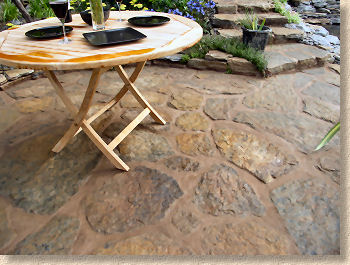
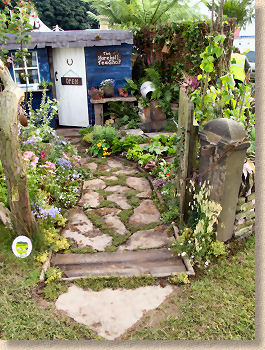
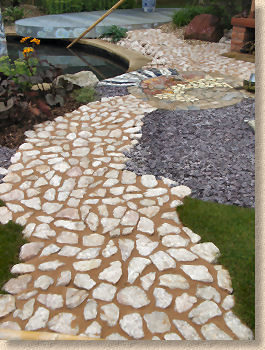
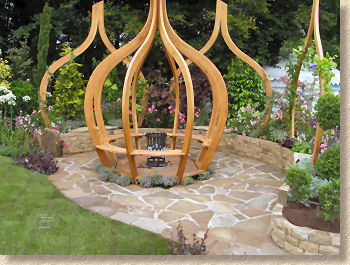
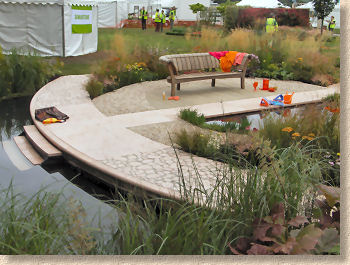
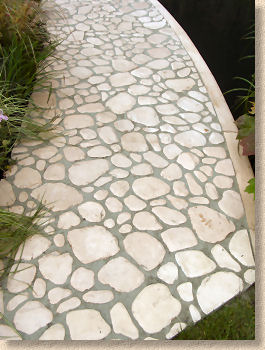
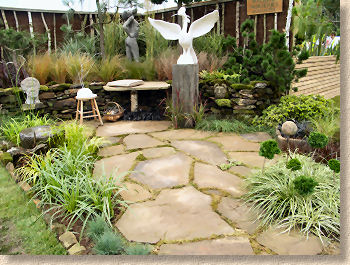
I think that series of photies makes the point. Crazy paving really does seem to be this year's in-thing. Is this a reflection of the exceptionally high price of good quality reclaimed stone, which can command more money than newly-quarried stone, or is it just coincidence?
There must be something in the air that alerts designers to latest trends: how else to explain the rash of 1970s style crazy paving that appeared at this event? What next: Pampas grass? Avocado bathroom suites? Screen walling?
Going for Gravel
The other popular paving trend was that old favourite, Breedon Gravel . Now, whether this was because of the impending cock-up guidance from Defra regarding permeable paving , or whether it can be put down to serendipity is hard to say. The designers to whom I managed to speak mostly chose it for its loose texture and ease of installation, but appreciated its free-draining properties as being very 'now'. Whatever, it made an appearance on several gardens ...
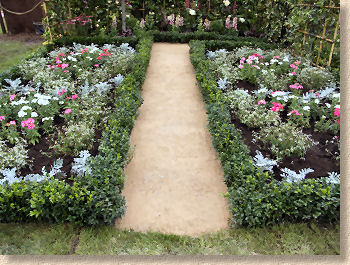
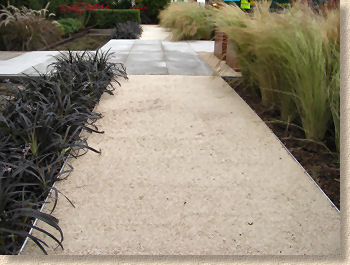
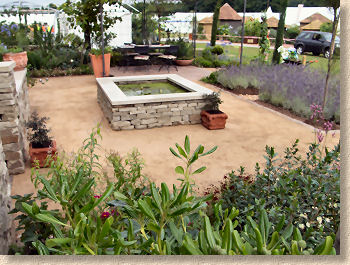
Good old northern stone
It wouldn't be Tatton without there being yorkstone flags, of both the new and reclaimed varieties. While the reclaimed varied in condition, texture, and standard of laying, the new stuff was invariably sawn-six-sides and honed, which does seem to be the way many designers prefer to use it in contemporary gardens.
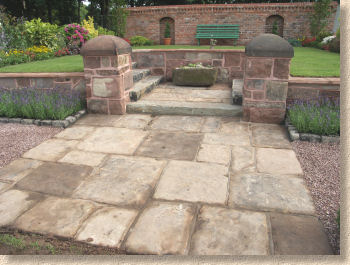
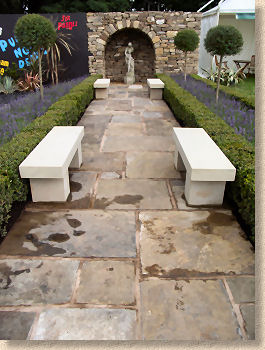
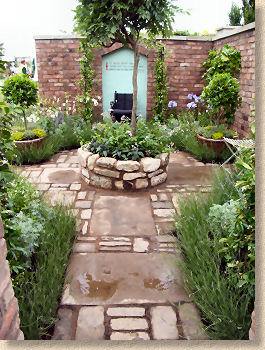
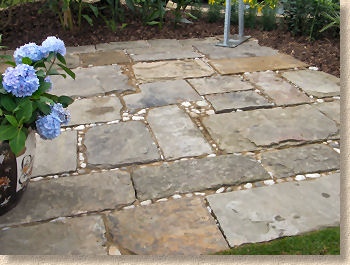
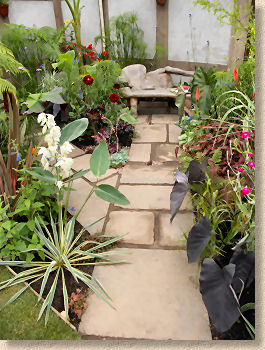
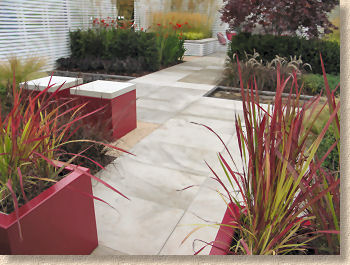
The greyer, more neutral tones of yorkstone were slightly more popular, and a couple of gardens made a feature of having distinctively wide joints filled with resin-bound aggregates of various sizes, which worked well, but raises the question of what happens when those joints fill with all the usual detritus that accumulates in gardens?
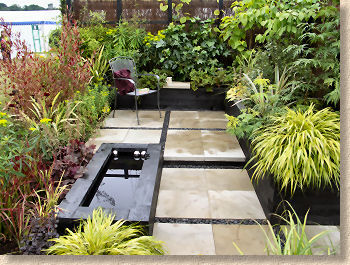
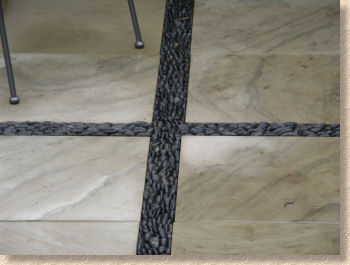
An even more troubling question regards the banded yorkstone laid in a sweeping path to the Samaritan's Garden . Were they intended to be laid with the trip hazards between adjacent flag, and if so: why? No-one on the Samaritan's crew was able to answer, so it remains a mystery, but I really do not like this. It's dangerous and it's silly. On the other side of the 'circle of life' path, a neat buff-coloured and wonderfully smooth resin bound aggregate had been laid up to an acrylic bridge with internal lighting, and so the odd decision to lay trip hazard yorkstone flags was even more puzzling. Perhaps it was meant to be a metaphor about life's bumpy path?
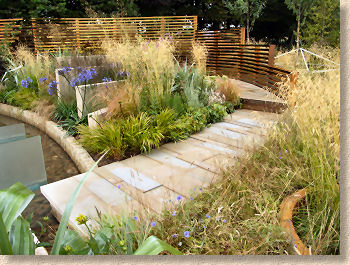
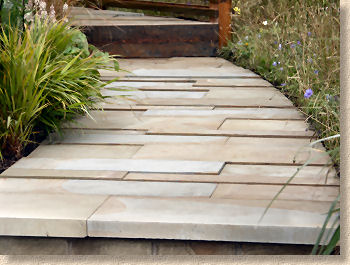
Urban Vision Partnership and The Casey Group rightly won a Gold Medal for the stunning East Meets West Garden, with its twin waterfalls, yorkstone cube stepping stones across a sunken pool, floating decks and serene slate walling. They were busily trying to set up a Oriental Tea Ceremony while I was there, and, if I'd had the time, a good cup of Lapsang Souchong in such a wonderfully stylish garden would have been perfect. The use of resin-bound black 6mm aggregate really sets off the grey yorkstone and helps draw the eye through the design. Admittedly, you're not likely to see this sort of garden at the back of your average Barrat Home, but we all need to dream, occasionally!
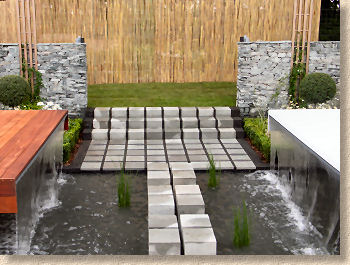
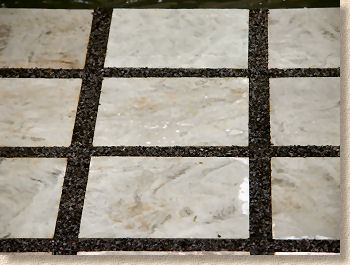
Imported Stone
A few years back, Indian sandstone (and other imported stone) was bloody everywhere, but its profligacy has all but killed what cachet it had, and it was barely present at all at this year's show.
Yes: some of the less adventurous had used it, and as already noted, it made an uncomfortable appearance in the Best In Show garden, but there was only one original use, and that honour went to the weirdly juxtaposed Punk Garden. By diagonally cutting a standard 840x560mm flagstone and then offsetting the two pieces, a wonderfully jagged and spiky a la Mohican pathway can be easily created. See! Even after all this years looking at paving, there are still new wonders to behold!
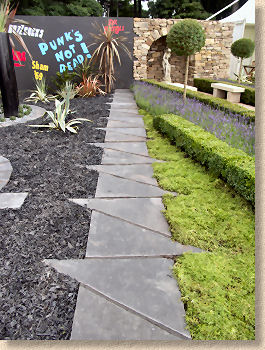
Sadly, the ... yawn ... uninspiring fare of ... yawn ... feature circles ... yawn ... and straightforward patios ... yawn ... continues. This is a major garden design event - show a bit of imagination, will you? There's nowt wrong with circle features, per se, but at an event where designers ought to be looking to show off their invention and imagination, a bog-standard, straight-out-of-the-brochure circle feature isn't going to set the world alight.
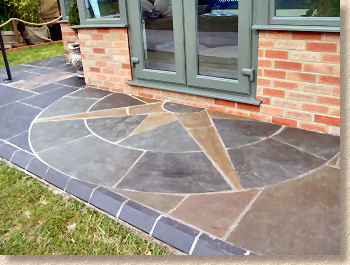
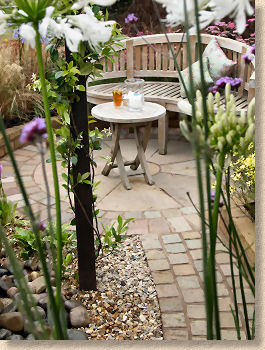
Concrete paving
It would be easy to think that concrete paving has been completely put to flight by the popularity of natural stone. Indeed, going back to that Chesley show in May, only one Show Garden used concrete as its hard-landscaping medium, and although the garden was cruelly overlooked and under-appreciated by being given a mere bronze medal, the public ultimately revealed taste and sensibility greater than that of the learned judges and voted it "The People's Choice".
That garden was the Brett Real Life Garden designed by Geoffrey Whiten, and it proved that the great unwashed still prefer to see gardens that they can envisage outside their own kitchen window. Trees at thirty grand a pop are all well and good, but they are a non-starter for most punters. Show them a well designed and comfy patio; give them a simple, attractive water feature; and provide attractive family-friendly, low-maintenance planting. That's a family garden. And that's what Brett and Geoff did once again, bringing a new, slightly smaller version of the Real Life Garden to their first showing at Tatton.
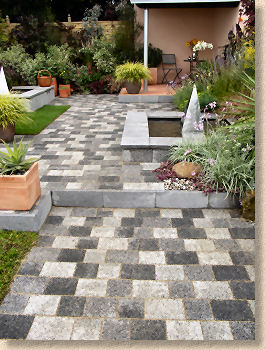
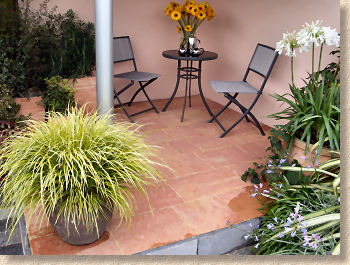
Brett are the only major paving manufacturer to put together a garden at Tatton. Some other manufacturers provided limited support to various gardens, but Brett put their money where the mouth is, by financing a whole garden, and reaped the rewards by being deemed worthy of a well-deserved Silver Gilt medal.
Zack Barrett, Brett's Marketing Services Manager, said:
"We are absolutely delighted to have marked our debut at Tatton Park by winning a Silver Gilt medal.
Sponsoring a garden at Tatton Park is a great opportunity to create an inspirational garden with landscaping and garden products that create a delightful outside space. Tatton Park is a spectacular show, which enables us to introduce consumers to our superb range of landscaping products."
The theme for the Real Life by Brett garden is adaptability and sustainability. "It's all about real life aspirations and providing a flexible outdoor space that's perfect for everyday living" , said Zack.
"Everyone's aspirations change over the years so our garden is designed to change with them and can be adapted to suit each stage of your life. At the same time, we wanted to create something that everyone could easily aspire to, no matter what their experience of gardening or the size of their plot."
Geoff Whiten added:
"Like the Chelsea garden, the Tatton Park design is something that anyone can aspire to. The sleek, raised stainless steel water fountains and bold architectural planting perfectly complement the crisp, modern lines of the garden's modular block paving. With a relaxing, contemporary alcove as its focal point, the Real Life by Brett garden is the perfect place in which to unwind."
It was a delightful family garden, but more importantly for me and other paving aficionados (flag-heads?), Brett had decided to use the event to unveil two new, as-yet-unnamed products that they hope to deliver to the market later in the season. The first is a truly gorgeous washed aggregate, granite-like face-mix block paver that comes in three 'shades' and is my new favourite granite-alike paver. The blocks have a deckle edge that gives an even greater natural look, but it is the shrewd choice tones that really make it work and will convince many that it is genuine granite.
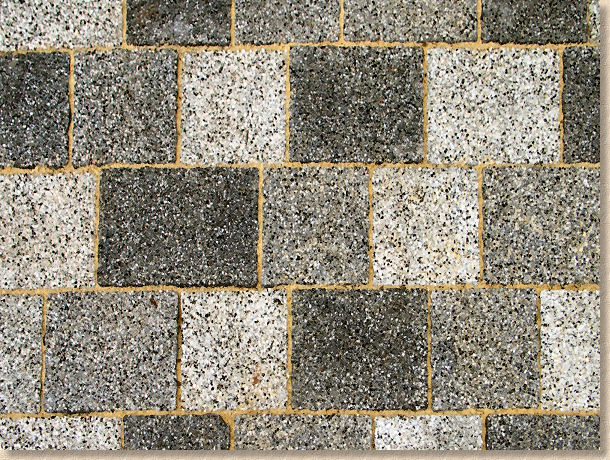
Nothing is finalised with the product yet. No decision on name or pricing, not sure when it will be launched, or in how many size formats, this was just an exercise to test public response to it, and if I count as a member of the public, then I say it's a winner!
At the back of the garden, a sheltered raised dais was paved using a new terracotta coloured flagstone. Rather than being a consistent terracotta hue, these flags, which were shown in three different sizes, have a slightly streaky appearance, the terracotta shot through with a lighter tone of buff. I'm less certain of the potential for this product. Terracotta, as a colour, is a few years out of date, although there is a steady level of interest from those determined to recreate the Mediterranean in their garden. It is a better, more realistic terracotta than most of its predecessors, and it's certainly very summery, so it may just do the trick.
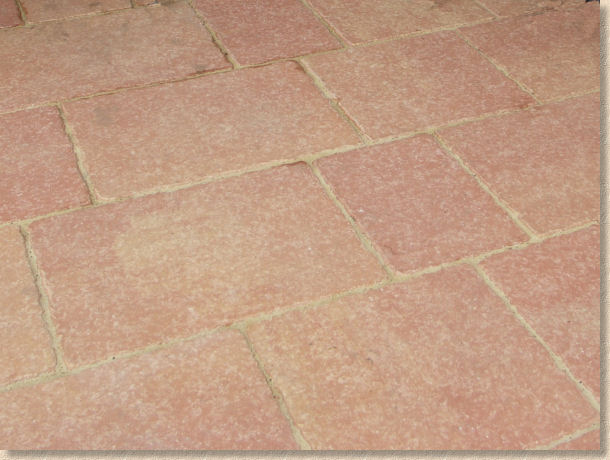
Another granitic block paver was used by Philip Hinchcliffe in his Cultivating Young Minds garden. I was giving this garden the beady eye literally moments before the judges arrived and Philip was frantically sweeping and washing and tidying; he even had his parents drafted in, and it was one mad panic. Not wanting to interfere in the judging process, I scuttled away to return later once the judging was done and Philip had regained his breath. He was concerned about his garden, but it was completely unwarranted, as evidenced by his subsequent Bronze medal, which is not bad for a young designer doing their first show garden at an event such as this.
Philip had used fairly standard "off-the-shelf" paving products, including concrete riven-effect feature circles and granite-effect block pavers, to create a visually strong and compelling design that is incredibly simple but satisfying. This is a garden designed for use by children, and children from various schools contributed to the design. It's wheelchair accessible, with plenty of space and raised planting contained by vertical wooden palisades.
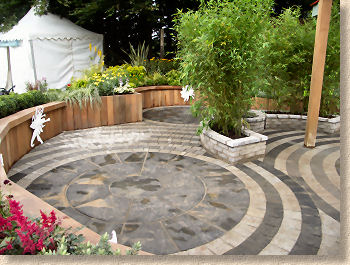
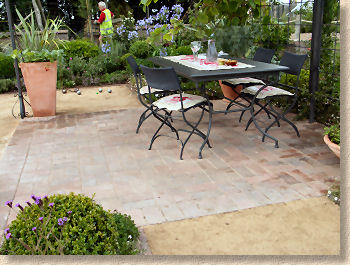
The only other notable use of concrete block paving, and, the only example of permeable block paving in any of the gardens could be found on Candy O'Connell's Cheshire Al Fresco garden. Given the aforementioned Defra guidance on permeable paving, it would not have come as a shock to see half-a-dozen gardens using CBPP at this show, but it is a shock to see just one. Candy was mentioned earlier regarding her use of Breedon Gravel, but for the patio area, she chose Tobermore's permeable Hydropave CBPP in a warm heather blend, and complemented this with the Secura Grande modular retainer wall, which is ideal for low garden walls.
Christies Hospital, in Manchester, is renowned the world over for its work on cancer, and they commissioned a garden to commemorate a patient who, thanks to their pioneering work, is now able to spend many hours tending her own garden. A Garden for Grace is a sweet and romantic creation, said to mirror Grace's personality, and the use of what is now fairly standard paving is lifted above the humdrum by the use of various levels, with steps and sunken ponds creating a truly three-dimensional feel to the whole.
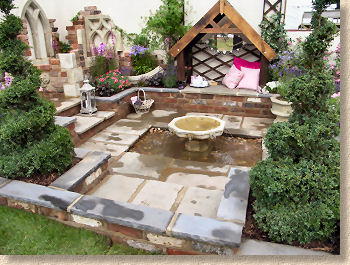
One of my pet hates when it comes to patio paving is stackbond in two colours: the chessboard effect. The nadir of this design is, I'm sure you'll all agree, the vomit-inducing red and buff "Noddy's House For One" combination, which is an internationally registered abomination that can earn neighbouring properties a rebate on their Council Tax for the pain and visual offence it causes. However, when the Cheshire Freemasons decided to create a garden, it would have been all but impossible not to use the fabled black-and-white chequerboard patterning found (allegedly) in lodges all over the world.
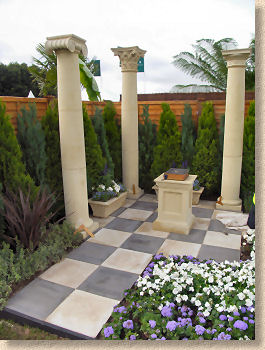
To be fair, it's quite attractive, in a limited way. I couldn't recommend it for a family patio, but it is bang-on-the-money for a garden celebrating Freemasonry. The key to success with this colour scheme is finding a genuinely black black. Most paving manufacturers use dark euphemisms such as “Charcoal” or “Anthracite”, because the best they can achieve is a deep grey. This paving by Haddonstone, who also provided the pillars and other hard-landscaping, is about as close to black as it is possible to get using concrete. A sealant would have made for a really black finish, but the intention was clear, and, against my better judgement, it actually worked!
A splash of colour
Brightly coloured decorative aggregates were featured in a number of gardens, but none as effectively as the luscious purple-coloured crag (crushed shells) used to form a curling pathway on the Metamorphosis garden by Reaseheath College . Visually stunning, and a worthy winner of a Silver Gilt medal, this garden simply underlines the fact that Reaseheath is a real hot-bed of talent for the landscaping industry. Best in Show Back-to-Back and Gold for the Reasheath Alumni, Silver Gilt by the current crop of students, and first two places in the UK Landscaping Skills Championships back in January prove that this is no one-hit wonder.
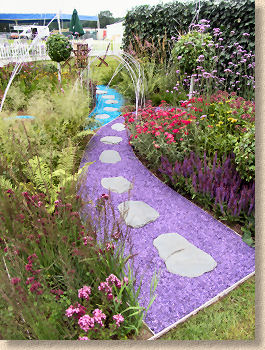
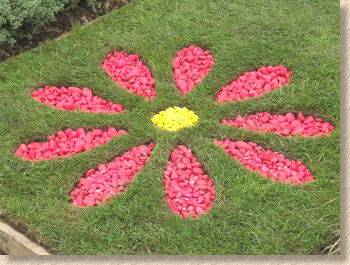
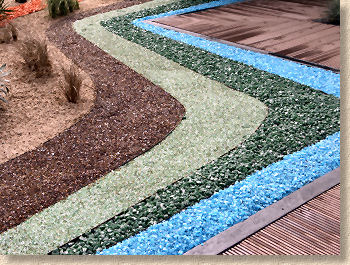
Oh dear!
If there are medals for great gardens and plaudits for great looking paving, then there should be The Rusty Trowel Award for the worst paving at the show, and the runaway winner for truly awful workmanship must go to this...
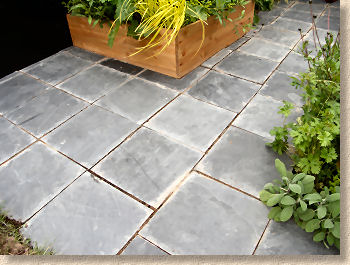
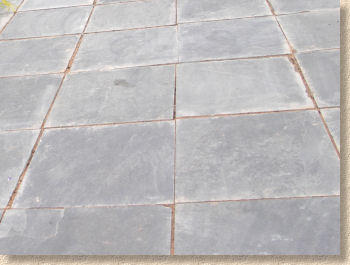
I won't name the culprit, as he doesn't deserve the publicity, but it was the only Back-to-Back garden not to win anything, and rightly so. It's chuffing dreadful. If you're responsible for this mess and you're reading this, do us all a favour and find another line of work. Hard-landscaping is not for you, pal!
Summery Summary
So there it is. As usual, what starts out as a couple of pages on what was seen ends up taking two days, or twice as long as the amount of time actually spent at the show. For me the highlights would be Jackie Knight's lovely Lancashire gritstone waterfall and onion structures, Brett's new granite-like block paving, and a small garden with no paving apart from a simple slate clapper bridge, but a wonderfully calm atmosphere. They named it Paradise Isle - A Western View . I wish I was there now!
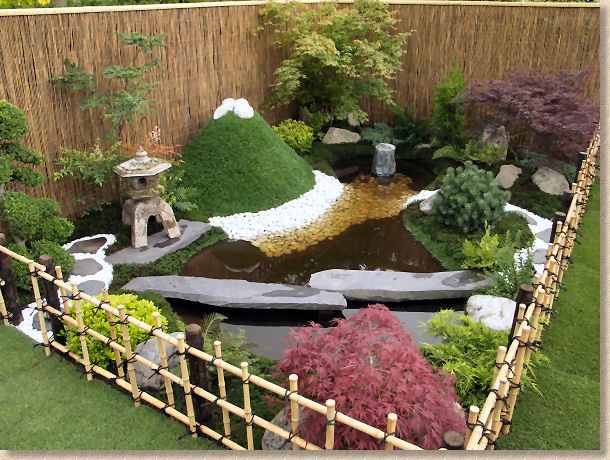
The lack of visible support from most of our hard-landscaping manufacturers remains a serious disappointment to me. There are at least half-a-dozen medium-to-large manufacturers located within an hour of Tatton, yet the only one to make an effort was Brett, from 250 miles away in Kent. As an industry, the hard-landscaping trade should do more to promote best products and best practice at this unique event, and that will require a concerted effort from both manufacturers and installers. Gardens are more than flowers and shrubs and vegetables - without hard-landscaping they are unstructured, inaccessible and non-functioning. We should be doing more to emphasise that point.
In regard of the show itself, there's a sense of it becoming a little too disparate. The main show gardens are now well-establised in their location girdling the so-called Egerton Clump, but a second site for show gardens up against the Saddleback Plantation seems detached and remote. However that is nothing compared to the apparently random scattering of Back-to-Back gardens, here, there and everywhere. There's no logic to their location, with a couple of gardens (the superb Reaseheath Metamorphosis and Andrew Loudon's Gold-winning Lake District Poet's Garden ) completely alone and nowhere near any others. Given the lack of recognisable landmarks, it's very easy to lose oneself at this event, and in the process overlook real gems in the labyrinthine disorganisation that is becoming a worrying trademark of the Tatton Show.


